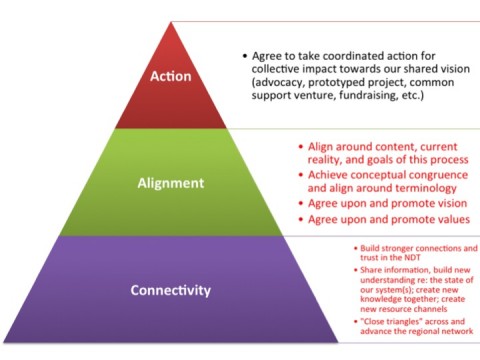Network Balancing Acts
February 28, 2013 3 Comments While doing some research on network evaluation techniques, I stumbled on a very helpful and interesting resource entitled “Network Evaluation: Cultivating Healthy Networks for Social Change” by Eli Malinsky and Chad Lubelsky (respectively for the Centre for Social Innovation and the Canada Millenium Scholarship Foundation). While it dates back to 2008 (5 years seeming like eons these days), the paper does a nice job of raising some of the inherent and necessary tensions and balancing acts of engaging in “net work.” I lifted a number of quotes from the paper as a preface to some thoughts about network value, which I laid out according to a framework that I developed (see above) using the work of Peter Plastrik and Madeleine Taylor in their seminal “Net Gains: A Handbook for Network Builders Seeking Social Change.”
While doing some research on network evaluation techniques, I stumbled on a very helpful and interesting resource entitled “Network Evaluation: Cultivating Healthy Networks for Social Change” by Eli Malinsky and Chad Lubelsky (respectively for the Centre for Social Innovation and the Canada Millenium Scholarship Foundation). While it dates back to 2008 (5 years seeming like eons these days), the paper does a nice job of raising some of the inherent and necessary tensions and balancing acts of engaging in “net work.” I lifted a number of quotes from the paper as a preface to some thoughts about network value, which I laid out according to a framework that I developed (see above) using the work of Peter Plastrik and Madeleine Taylor in their seminal “Net Gains: A Handbook for Network Builders Seeking Social Change.”
The idea underlying the framework, as laid out by Plastrik and Taylor, is that network value is diverse and depends upon its particular type or modality. At the level of connectivity, we see gains made through trust and relationship building, the rewiring of connections in the system, information sharing and developing new knowledge. At the level of alignment, value is gained through intentional development of shared value propositions in the form of mutual goals, shared vision and values, and overall ideological and conceptual congruence, whether or not people formally coordinate action. And then action is about just that, joint and coordinated effort towards a clear and tangible outcome.
And here’s the thing, net work is always shifting and changing and is meant to be dynamically responsive to changing conditions, membership, and goals. So no matter where we settle in terms of our aspirations for network outcomes, there is need for a spirit of flexibility and adaptability. Here is where I find the writings of Malinsky and Lubelsky particularly helpful, as they in essence offer up great grist for ongoing reflection in our shared endeavors:
“Networks exist in a balance between chaos and order. They tend to be more chaotic than other linear forms of organization, and yet a degree of order must exist throughout the network to give it some form and structure. Different networks have different degrees of balance between chaos and order, and the degree of balance may vary over time. Moreover, different segments of the network may occupy different places at any given moment.”
“Many networks are based on connections between organizational members—but it is really individual members who participate as representatives of their organizations. This impacts on a network in several significant ways. What happens when a key individual network participant leaves an organization? How restricted are participants by their organizational contexts? How does a healthy network navigate this tension?”
“There are both formal and informal networks. That is, one may be explicitly part of a network, and thus subject to specific requirements and benefits, or one may be connected in an unstructured way with others. A network itself may have formal and informal components, while individual members may also have formal or informal roles within it.”
“Is a heterogeneous network healthier than a homogeneous network, or does it depend on the context? Does a homogeneous network achieve more sooner, while a heterogeneous network produces more innovation by exposing members to new ideas? Some networks intentionally occupy a specific space within this spectrum based on their missions, while others default into a space based on the limitations of their connections.”
3 Comments
Great post, Curtis. It seems to me that if we get to know one another outside of our organizational realms and in a variety of contexts, we can reduce the risk of being hemmed in by organizational affiliation.
We can also reduce the likelihood of limiting network effectiveness by making sure there are opportunities to get to know more than one representative from each organization. One technique that works is “bring a colleague to the network” events that are part work/part social time – modeled on the “Bring our daughters and sons to work” days. This is especially effective if the colleagues who attend have a role in the organization that could benefit directly from the network’s work in obvious ways.
Carole,
I like your idea of “bring a colleague to the network”! Makes a lot of sense. And I am so appreciative of how fundamentally you model the network ethic in what you do and who you are.
Curtis
Curtis,
This is a great post! A network is only as strong as its ability to connect ties and hold its space. Connectivity to me is the foundation of network building and structural transformation.